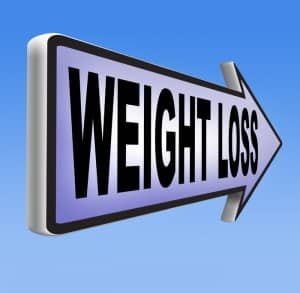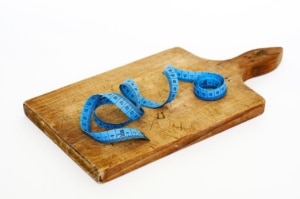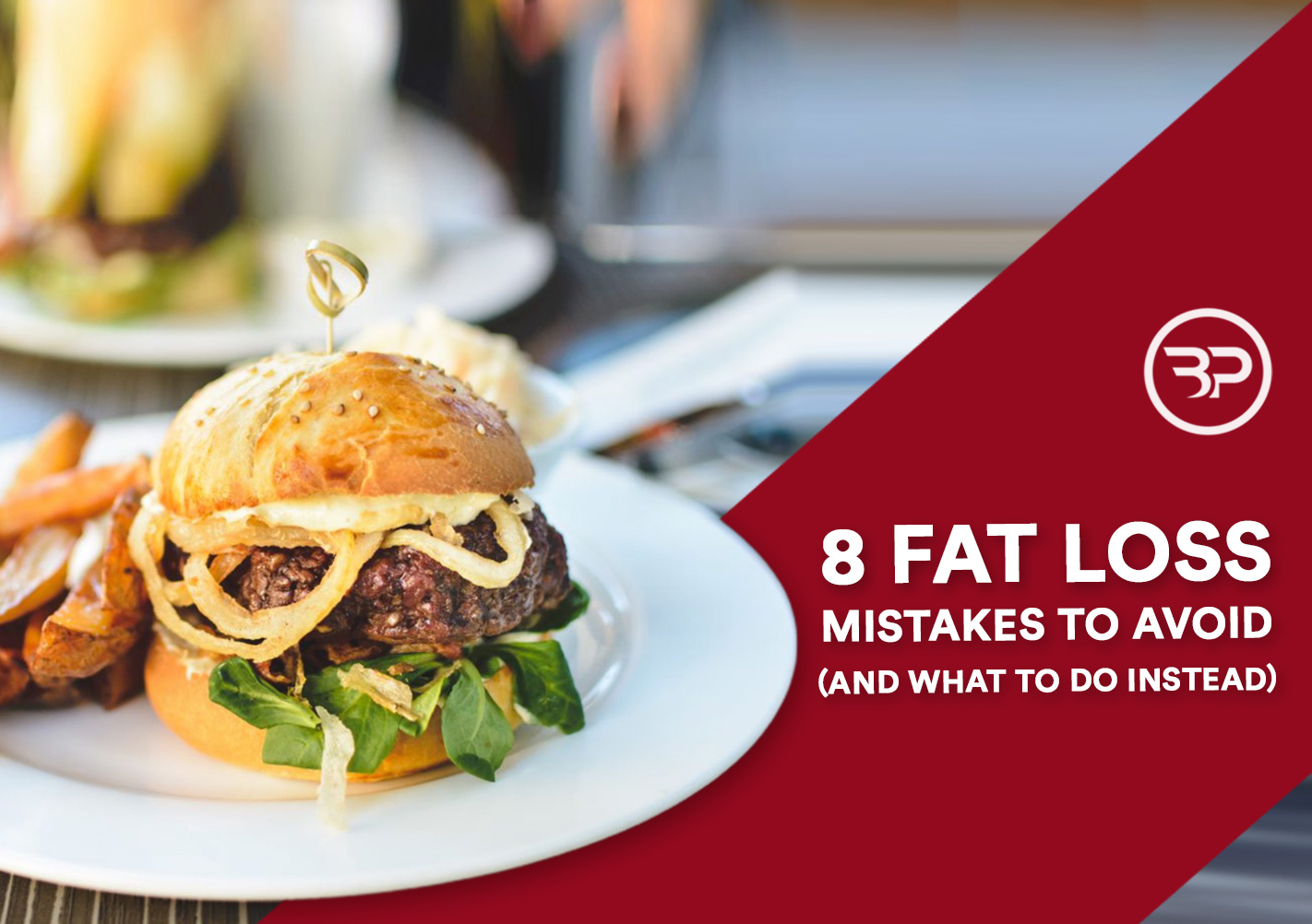8 Fat Loss Mistakes To Avoid (And What To Do Instead)
February 6, 2018
Guest Post By Sam Forget
When you want to lose fat, the last thing you want to do is waste time and effort.
Stop the self-sabotage. Start doing the right things in the right ways to ensure success.
Here are eight common fat loss mistakes and how you can avoid them.
Mistake #1: Not Having a Clear “Why”
You think: “Eh, I just want to lose some weight you know? Look a little better I guess.”
Ah, nice.
Unfortunately, when fat loss gets tough (and it will) “losing some weight” and “looking a little better” aren’t effective motivators.
You have to dig deeper, or you’ll never make it through the tough times.
Let’s pick apart “losing some weight” as in: “I just want to lose some weight, you know?”
“Why?”
“Well, I have some belly fat that bothers me.”
“Why does that matter?”
“I don’t feel confident around my wife anymore, and being this overweight limits my ability to play with my kids.”
>>> See what just happened there?
The boring, uninspired “just want to lose some weight” turned into “getting a strong, capable body that your wife is attracted to and can actually keep up with the kids.”
The Takeaway: Take some time to evaluate the meaningful, deep reason(s) you want to lose fat in the first place.
Mistake #2: Planning For What’s Out of Your Control
You need clear process goals, not outcome goals.
An outcome goal is “lose 30 pounds.” Outcome goals are mostly out of our control.
A process goal is “eat 1,900 calories a day.” A process goal is within our control.
There’s nothing inherently wrong with an outcome goal. But it should be accompanied by clear, measurable action steps that you can work on daily.

Let’s use the outcome goal of “get better sleep.” What process goals can you attach to it?
How about:
- I will leave all electronics outside of my room every night
- I will record my wake-ups and bedtimes to track overall sleep habits
- I will practice a bedtime ritual of reading, brushing my teeth, and yoga
Each of those can be measured, tracked, and will get your closer to your outcome goal.
The Takeaway: Once you’ve found your deep “why,” you need a specific “how,” before your planning even begins.
Mistake #3: Having Unrealistic Expectations
This one isn’t entirely your fault.
Mainstream fitness marketing has made “30 pounds in 6 weeks” sound doable. So have the fad diets that helped you drop 8-10 pounds of water weight in a week.
The truth?
Healthy, sustainable fat loss occurs at around 1% of your body weight each week. That means…
- A 180-pound person could aim for 1.8 pounds per week
- A 200-pound person could aim for 2.0 pounds per week
- A 220-pound person could aim for 2.2 pounds per week
Any faster, and you’ll risk losing muscle, strength, and crashing and burning a few weeks in.
There’s also a catch.
Around 1% per week is ideal fat loss, physiologically speaking.
But our lives don’t always provide ideal conditions for fat loss.
So before you whip out a calculator to see how long a 30-pound loss will take at 1.8 pounds per week, don’t forget to add “life” to those calculations.
Life can double your “ideal” timeline:
- 30 pounds in 6 weeks? I don’t think so
- 8 pounds in 7 days? Nope
- 1% per week, every week? Probably not
But a 1% loss most weeks, with the occasional 1-2 week plateau or setback?
Sounds about right.
In other words, that 30-pound loss might take 2, 4, or even 6+ months.
Gasp.
The Takeaway: Before you greedily consider that “too slow,” when was the last time you shed 30 pounds in a non-miserable way and kept it off?
Mistake #4: Going Out With A Bang
Many people think losing weight comes with a “do not eat” list. So they have one last hoorah of ice cream and booze. After starting, they’ll realize I don’t ban any food, and their binge wasn’t necessary.

If you feel the need to binge all your favorite foods before starting a fat loss plan, that’s a huge red flag.
It says:”I have no idea how to incorporate these foods in a healthy way so I’m going to cut them out altogether.”
This means the diet you’re planning on stinks—a lot.
An effective fat loss plan is sustainable.
In other words, unless you plan to cut out wings, burgers, and beer forever… you shouldn’t cut it out of your diet altogether right now.
It won’t last.
But here’s the good news.
The Takeaway: As long as your total calories are in check, you can still eat your favorite treats in moderation and lose fat.
Just make sure you “spend” most of your calories on the good stuff.
Mistake # 5: Not Tracking Progress
You don’t love the way you look right now and want nothing to do with exposing that. Nobody wants to look at (or measure) their own gut.
But you’ll regret not taking initial progress measures—like photos, measurements, and weigh-ins—for two reasons:

(1) They can keep you on track. The scale fluctuates quite a bit. If you’re not tracking weekly averages, you may mistakenly think you’re not making progress. Tape measurements might show progress when the scale isn’t moving—as will monthly progress photos.
(2) You’ll want them after your body changes. When you do successfully transform your body, you’ll regret not having good “before” photos to see how far you’ve come. Plus, you’ll be curious how many pounds and inches it took to get there.
Mistake #6: Focusing on the Wrong Things in the Gym
To drop fat, you’ll need to burn more calories than you take in. That’s called creating a deficit.
You’ll obviously burn some calories during your workouts. But you’ll want most of your caloric deficit to come from your nutrition.
Your nutrition will promote weight loss, and your workouts will dictate what kind of weight it is. The main goal of your workouts during a fat loss phase should be sparing muscle.
There’s no need to do endless circuits or grueling cardio sessions.
Instead, strength train 3-4 days per week with a focus on compound movements (rows, presses, deadlifts, squats, carries, etc.) Track your progress and try to improve, or at least maintain, your strength in a variety of rep ranges.
You’ll spare much more muscle than you would by becoming best friends with a treadmill, provided you’re getting enough protein (.8-1 grams per pound of bodyweight.)
If you want, you can also add 1-2 conditioning sessions per week. Think jump rope, hill sprints, etc. But if you’ve never been consistent with 3-4 days of strength training before, nail that for a while first.
Mistake #7: Making Drastic Changes Out of the Gate
Trying to go from Big Macs to grass-fed bison and kale?
From the couch to daily beach sprints and jump rope?
The Takeaway: That’s not a good idea. Although it’s well-intentioned, those are huge jumps to take. Huge jumps don’t last long.
When beginning a fat loss plan, aim for the “low-hanging fruit.” These are the things that offer a big return for very little effort. Such as:
- Scheduling your workouts in advance on a calendar (more consistency)
- Leaving your phone out of the bedroom (MUCH better sleep)
- Drinking more water (increased energy and decreased hunger)
- Keeping junk food out of the house (makes it impossible to fall off track)
- Recording your workouts (easier to monitor improvements)
- Planning meals the night before (less decision-making = fewer screw-ups)
There’s no need to overhaul your life in a week.
We want the same methods that helped you to lose fat, to be the same methods to help you keep it off.
Be realistic.
Mistake #8: Going It Alone
 The most successful people in any field outsource what they’re not great at. If you’ve never been able to crush a fat loss plan on your own, it’s time to consider hiring a coach.
The most successful people in any field outsource what they’re not great at. If you’ve never been able to crush a fat loss plan on your own, it’s time to consider hiring a coach.
A surprisingly large number of fitness coaches hire their own fat loss coaches. That’s because they understand the value of coaching.
They get the support and accountability they need to be consistent. And so can you. Imagine having to somebody to answer every time you feel like quitting?
The Takeaway: It’s nice to get a helping hand or kick in the butt here and there. If you’re not quite ready for coaching, enlisting the help of a workout partner can also be helpful.
Your Next Steps
It may seem like there are a lot of mistakes to avoid, but in reality, it’s quite simple.
To recap:
Find a clear “why” and aim for realistic goals within your control. Take initial progress measures before beginning a sustainable, realistic plan. Make slow changes over time and consider hiring a coach if you struggle with consistency.
Above all else, aim for progress—not perfection.
You will have that strong, lean, capable body that you’ve always wanted.
But you’re not going to get there by being “perfect.” You’ll get there by being consistent.
If you’re patient and trust the process, you’ll make it happen.
About The Author
Sam Forget, the owner of Hercules Performance, specializes in helping regular people simplify and de-stress the fat loss process. When he’s not working, he’s probably with his dogs or daydreaming about his next tattoo. Sam has put together a guide on how to stick to your fitness plan when you’re NOT feeling motivated. You can snag your free copy and discover the top five proven methods for sticking to your plan here.







